What's New
Displaying results 3911 - 3920 of 4914
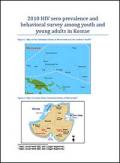
Resource | Publications,
In 2009/2010, an STI biological and behavioral survey among youth and young adults in Kosrae, in the Federated States of Micronesia was conducted. Its aims were to assess the prevalence of key STIs among adults in Kosrae as well as evaluate certain knowledge and risk behaviours in order to better identify how to deliver targeted interventions aiming to reduce risk of HIV and STI infections. 361 participants aged between 15 and 49 were recruited from Kosrae.

Resource | Publications,
The overall goal of the National Policy on HIV/AIDS is to provide for a framework for leadership and coordination of the National multi-sectoral response to the HIV/AIDS epidemic. This includes formulation, by all sectors, of appropriate interventions which will be effective in preventing transmission of HIV/AIDS and other sexually transmitted infections, protecting and supporting vulnerable groups, mitigating the social and economic impact of HIV/AIDS. It also provides for the framework for strengthening the capacity of institutions, communities and individuals in all sectors to arrest the spread of the epidemic. Being a social, cultural and economic problem, prevention and control of HIV/AIDS epidemic will very much depend on effective community based prevention, care and support interventions.
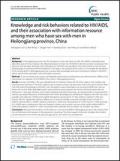
Resource | Publications,
In Heilongjiang province, the HIV prevalence in men who have sex with men (MSM) is generally lower than other part of China. However, the official perception for their risk of HIV/AIDS infection has been increasing in the province over the years. Moreover, little information on HIV/AIDS was provided to the communities so that we have disadvantage of controlling HIV/AIDS epidemic in the region. The purpose of this study is to investigate the prevalence of HIV among MSM in Heilongjiang province, to assess their knowledge levels and risk behaviors related to HIV/AIDS, and to explore their associations with information resources.
A cross-sectional study using a standardized questionnaire and blood test was administered in 2008 by local interviewers to a sample (1353) of MSM in four cities in Heilongjiang province.
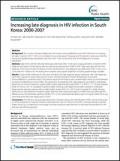
Resource | Publications,
The number of Koreans diagnosed with human immunodeficiency virus (HIV) infections is increasing annually; however, CD4+ T-cell counts at diagnosis have decreased. The purpose of the present study was to identify clinical and epidemiologic associations with low CD4+ T-cell counts at the time of HIV diagnosis in a Korean population.
Data from 2,299 HIV-infected individuals with initial CD4+ T-cell counts measured within 6 months of HIV diagnosis and reason for HIV testing were recorded and measured from 2000 to 2007. Data were selected from the database of the Korea Centers for Disease Control and Prevention. Late diagnosis was defined by CD4+ T-cell counts<200 cells/mm3. Reasons for HIV testing were analyzed using logistic regression including epidemiologic variables.
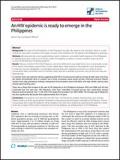
Resource | Reviews and Snapshots,
Southeast Asia is experiencing numerous and diverse HIV epidemics that are evolving at varying rates, in different population groups, and in different geographical areas. Approximately 5 to 10 million people are living with HIV in Asia, with prevalence estimates of well over 1% among adults in numerous countries. Yet there are some settings in which HIV prevalence has remained relatively very low. The Philippines is one of the exceptional countries that has not faced a large HIV epidemic. It is important to understand the reasons for the disparate nature of HIV in this country in order to ascertain whether lessons can be learnt for effective control in other settings and to ensure that a large HIV epidemic does not emerge in the Philippines.
The state of the HIV epidemic in the Philippines has been described as "low and slow", which is in stark
contrast to many other countries in the region. A review of the conditions for HIV spread in the Philippines is necessary.

Resource | Publications,
Men who have sex with men (MSM) have been harshly and disproportionately impacted upon by HIV and continue to be a major driver of the HIV/AIDS epidemic in the world. In the United States, MSM accounted for approximately 45% of newly reported HIV/AIDS diagnoses in 2006 and nearly 54% of cumulative AIDS diagnoses.
The prevalences of HIV and STDs were high among MSM in Chengdu. To prevent HIV/STDs, campaigns promoting condom use are needed not only to boost the frequency of condom use, but also to educate MSM about proper condom use.
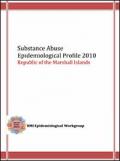
Resource | Publications,
This profile resulted from the collaborative efforts of the various agencies and institutions that comprise RMI Epidemiological Outcomes Workgroup (RMI Epi Workgroup) with coordination by Marshall Islands Epidemiology and Prevention Initiatives Inc. (MIEPI).
In this 2010 National Epi Profile, MIEPI has been able to collect additional substance abuse related data for the SPF SIG Bobrae Project through collaboration with project partners including WUTMI, PPP, and YTYIH. RMI will also continue to improve its RMI Epi Profile to integrate substance abuse treatment, recovery and mental health related data.

Resource | Presentations,
Since the first detection of HIV in Bangladesh in 1989, the rate of infection has not been increased in comparison to our neighbors. Bangladesh still to be low prevalent country in the region with prevalence < 1% among MARP.
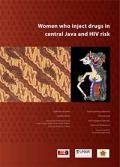
Resource | Publications,
HIV is a significant public health issue for Indonesia which, outside the Papuan provinces, has been largely driven by injecting drug use. The majority of people who inject drugs in Indonesia are men, so most of the research relating to HIV and injecting drug use has been with men. However, international experience identifies that the experience of women who inject is different to that of men and that gender-specific HIV prevention strategies are needed. Therefore, information about women who inject drugs in Indonesia is necessary for HIV policy and programs.
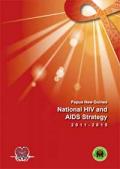
Resource | Publications,
The new National HIV and AIDS Strategy, 2011-2015 seeks to build on past achievements and address shortcomings in PNG’s response to the HIV epidemic. The NHS replaces the National Strategic Plan on HIV/AIDS, 2006-2010 (NSP). Its overarching goal is to reduce transmission of HIV and other sexually transmitted infections (STI) and minimise their impact on individuals, families and communities.
While there has been considerable progress in the response to HIV and AIDS, particularly considering the difficulties posed by PNG’s diverse geography, culture and complex epidemic, the harsh reality is that the HIV epidemic has been outpacing the national response. To address this, this new national strategy is significantly different to the previous NSP.





